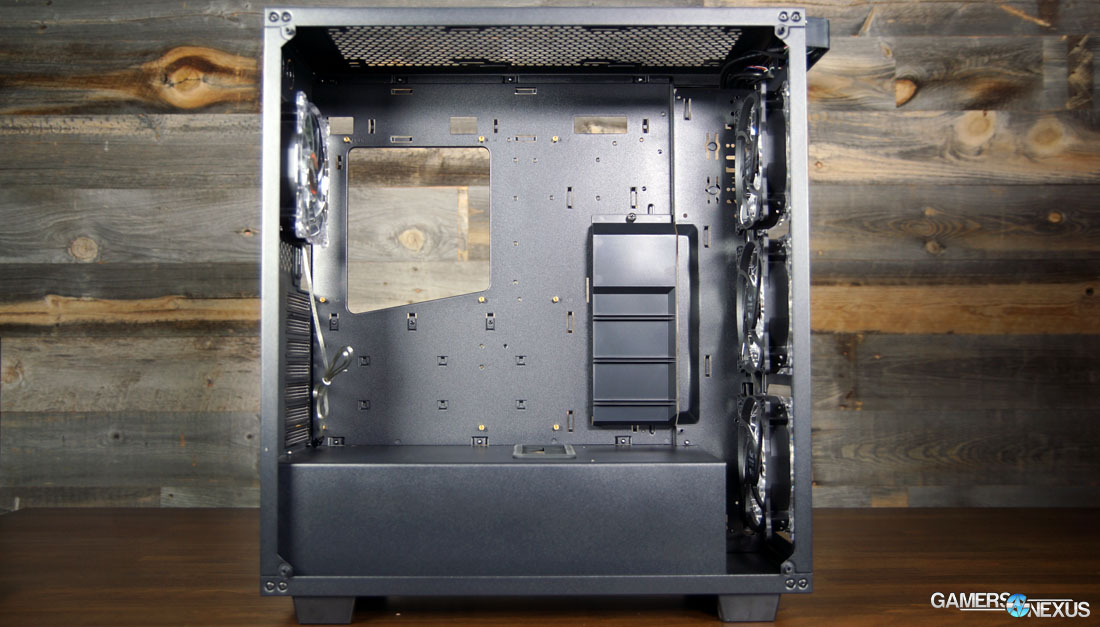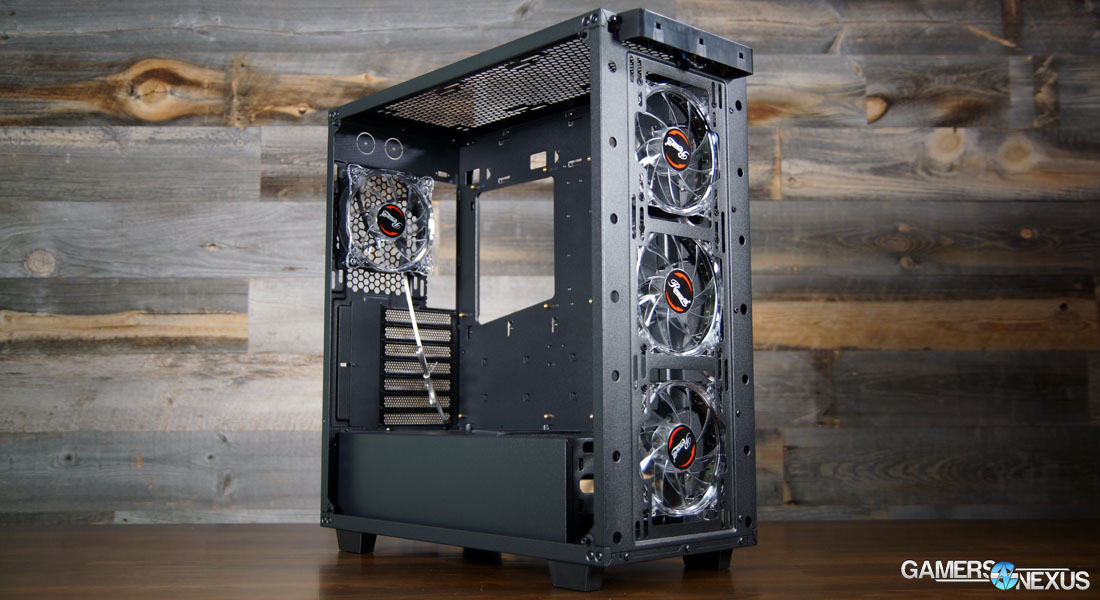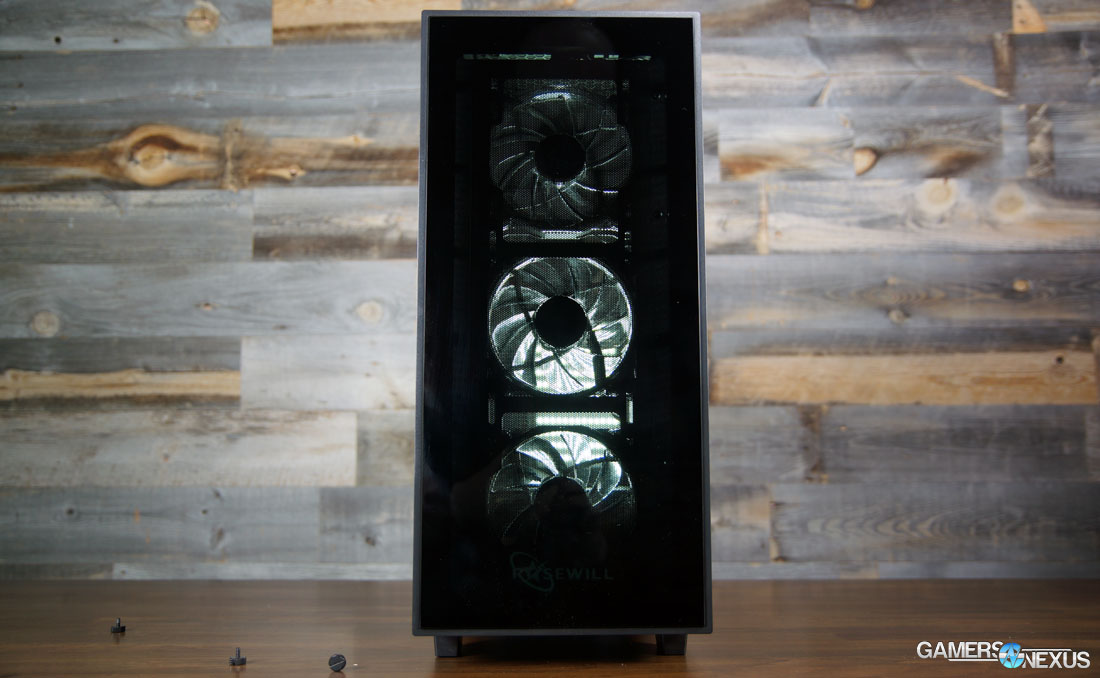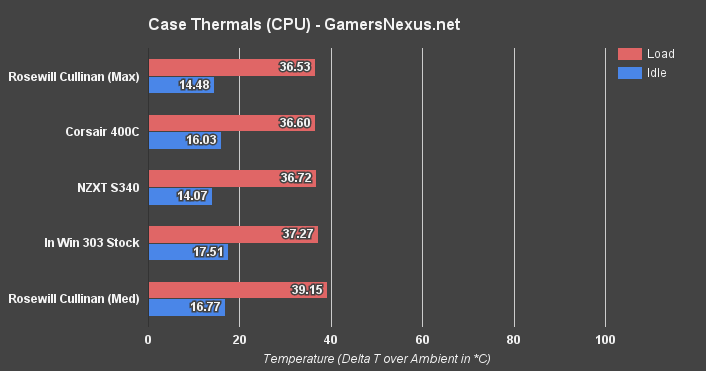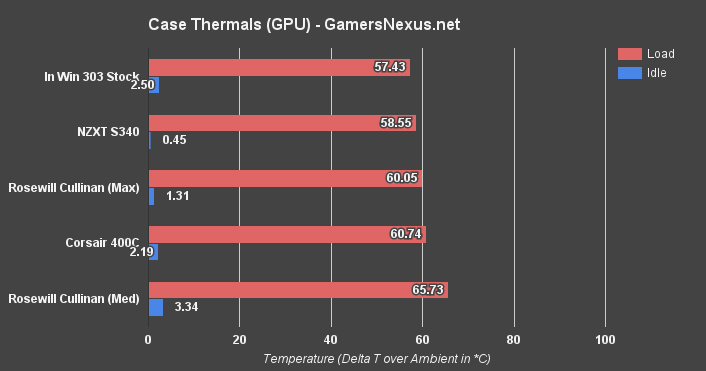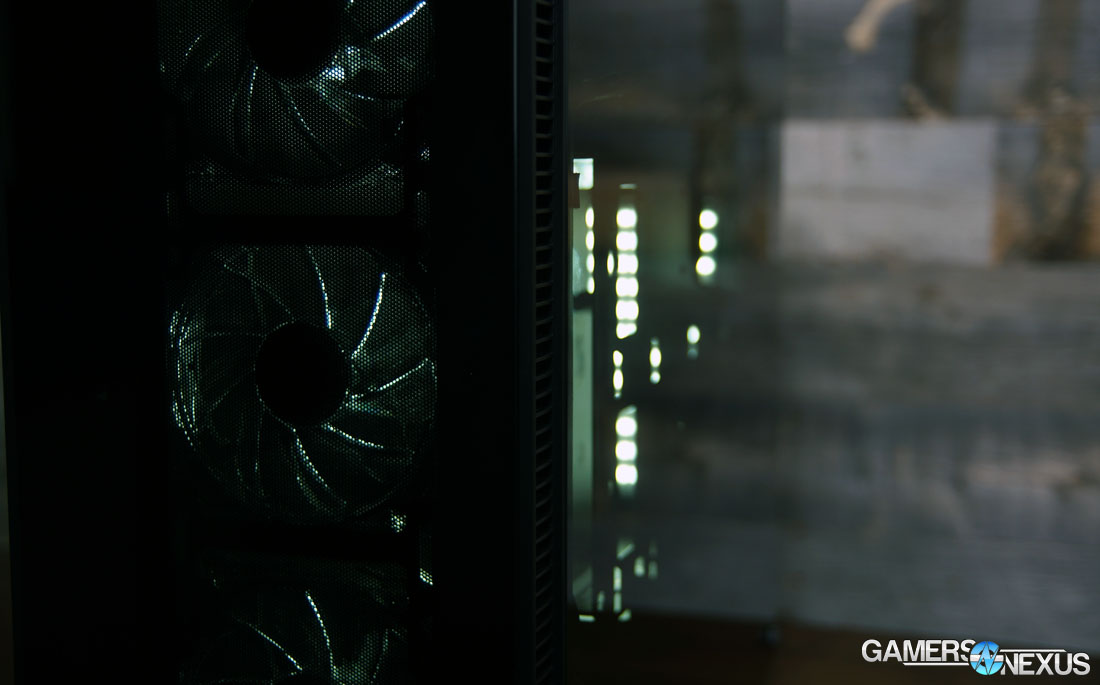Rosewill's Cullinan PC case is the company's most modern endeavor since the R5, and manages to get to the front of the case industry's current trends. It's a mid-tower with a PSU shroud and a full tempered glass side window, which is checking almost all the boxes created by NZXT's H440, In-Win's more expensive cases, and Corsair's 760T. The only 2016 trend missing from the Cullinan is a set of RGB LED fans, but they've still got blue LEDs.
We first saw the Rosewill Cullinan mid-tower at Computex 2016, but the case was impacted by shipping delays (and other internal delays) that pushed back its launch until now-ish. In theory, the ~$150 Cullinan will begin availability just before October, and should begin shipping to customers by the first week of October. That long lead-in to production has allowed competitors to enter the growing market of cases with tempered glass side panels, including Corsair with its brand new 460X, In Win with its 303, and Anidees with its identical AI Crystal ($150).
The Anidees AI Crystal and Rosewill Cullinan enclosures both boast 5mm thick tempered glass side windows and a 4mm thick tempered glass front panel. The enclosures target the front edge of a trend in the industry to adopt tempered glass on affordable cases (read: ~$100 to ~$200), replacing the cheaper acrylic that's found in almost all windowed panels. Rosewill and Anidees both use Chinese OEM designer Jonsbo, whom we believe to be a customer of case factory God Speed Casing. If that name's familiar, it's because God Speed Casing is the manufacturer used (and effectively grown) by NZXT; we've even toured their factories in China.
There's a good chance that the iBUYPOWER Element's production at God Speed Casing was seen by Jonsbo earlier this year, when the SI paired with NZXT to build an S340 with tempered glass paneling in the front and side. Since then, Jonsbo has begun producing its QT03 chassis, which bears striking resemblance to Rosewill's Cullinan and Anidees' AI Crystal.
It's “striking” because it's the same. Jonsbo does, convincingly, market its QT03 with the catch-phrase, “chasing on the road, have you already forgotten the beginner's mind?”
With copy like that, it's hard to believe that more manufacturers haven't ordered from the OEM.
Jonsbo is the OEM, here, but that doesn't diminish the fact that the Cullinan is generally a well-designed case – at least, for aesthetics. We'll look at the thermal benchmarks momentarily. The enclosure remains the most modern of Rosewill's current case portfolio, and is poised to attract more eyes to Rosewill's case lineup. This OEM/manufacturer relationship isn't new to the industry, either; we've exposed most of the liquid cooler suppliers and their partners (e.g. Asetek, CoolIT, and relations to Corsair or others), but the existence of a single supply doesn't invalidate a manufacturer's contributions. These companies are often involved in making change requests during development, instituting custom design or firmware changes (like Logitech's changes to the ADNS-9800 sensor from Avago, or Corsair's to Asetek's supply), and still carry recognition and support/warranty systems that matter.
The point is: It's not bad that Rosewill and Anidees are both using Jonsbo as a (likely) supplier, but it's still good to know as a consumer.
Regardless, we're reviewing the Rosewill Cullinan case today. If you're here to learn about our thoughts on the Anidees AI Crystal or Jonsbo QT03, you're in the right place – our thoughts will apply (nearly) equally to all three of these enclosures.
Rosewill Cullinan Specs
| Form Factor | Mid-Tower |
| Motherboard Support | mATX, ATX, XL-ATX, E-ATX |
| Expansion | 3x 3.5” 3x 2.5” (or 5x 2.5” if axing some 3.5”) 7x Expansion Slots |
| I/O | 2x USB3.0 2x USB2.0 2x 3.5mm 3-speed fan controller |
| Fans | 3x 120mm front (blue LED) pre-installed 1x 120mm rear (blue LED) pre-installed 3x 120mm/2x 140mm top (optional) 1x 140mm rear (optional, replaces stock) 3x 140mm front (optional, replaces stock) |
| Radiators | Support up to 360mm top/front 1x 120mm rear |
| Clearance | VGA: 420mm long CPU Cooler: 180mm tall PSU: 240mm long, better to stay closer to 200mm PSU Height: ~87-88mm |
| Price | $180 MSRP $150 street price |
The Cullinan has an expected street price of $150. For hard specs, the unit is using 5mm thick tempered glass side panels for the left and right, each secured by flathead thumbscrews in four locations. 4mm tempered glass is mounted within the front plastic housing (no screws). A silicone damper sits between the left/right screws and the glass to prevent unpleasant metal-on-glass contact, with the glass itself sitting loosely on a standoff.
Obstructing the front with tempered glass obviously prohibits any air intake, but this isn't any different from what we're seeing on modern cases making use of sleek plastic or steel fronts, either. The Corsair 400C, 600C, and NZXT H440 and S340 cases all uses flat fronts with no mesh, and then leverage the depth between the front of the front panel and the case frame as side intakes for front fans. It's an approach to design that allows for intake, a cleaner front, and theoretically reduced noise exposure to the user by directing fan noise out and away from the front of the case, toward the back, rather than leaking noise out a front mesh.
To make this work, however, the enclosure needs to have some depth between the front panel and the frame, and a grill within that cavity. We've found that a grill of about 1” is ideal for 'breathability' – the same is also true for bottom intakes on elevated cases – and the Cullinan meets this recommendation with a 1.2” gap.
For fans, the Cullinan includes 3x 120mm front fans with blue LEDs and 1x 120mm rear fan with blue LEDs. Optionally, 3x 120mm top fans can be fitted, though we've generally found that cooling performance worsens when using top exhaust fans with a tower cooler, so it'd be best to dedicate that slot to a radiator.
The Cullinan supports radiators up to 360mm long in the top and front. A 120mm radiator can be fitted in the rear; although 140mm fans are supported in the rear slot, not all radiators will fit depending on tank size.
Optionally, the front fans could be replaced with 140mm units, though you're really not gaining much from that endeavor other than potentially some noise reduction. The front fans are already fairly maxed out on their usage of the entire front surface area, with 140mm ultimately bleeding some of the air channel over the steel paneling.
The case's construction is entirely steel. Without the glass, the enclosure is fairly lightweight and uses 0.7mm thick SGCC steel. The glass helps with structural rigidity when mounted to the case.
Test Methodology
We tested using our Ivy Bridge test bench, detailed in the table below. This particular configuration has been retired and brought back into service, following some changes to our hardware availability. We’ve moved from a one-bench-fits-all setup (which uses a Haswell config in an mATX board) to multiple benches, one for mATX and small towers and one for ATX / mid-towers. This bench is for the latter.
Conducting thermal tests requires careful measurement of temperatures in the surrounding environment. We control for ambient by constantly measuring temperatures with thermocouples and laser readers. We then produce charts using a Delta T(emperature) over Ambient value. This value subtracts the thermo-logged ambient value from the measured diode temperatures, producing a delta report of thermals. AIDA64 is used for logging thermals of silicon components, including the GPU diode.
All case fans are manually configured to their maximum throughput using BIOS. If a fan controller is present, we opt-in and test on multiple settings. This forces testing of case fan performance in addition to the case's air channeling and airstream design. This also ensures minimal variance when testing, as automatically controlled fan speeds can reduce reliability of benchmarking. The CPU fan is set to use a custom fan curve that was devised in-house after a series of testing; setting the CPU fan to its maximum speed can limit the disparity shown from case-to-case as the CPU cooler is extremely efficient, and will create a ceiling for thermal performance if bottlenecked.
The CPU is overclocked to 3.6GHz with all power saving features disabled and EIST disabled.
| Component | Courtesy Of | Price | |
| Video Card | GTX 980 Reference (PhysX) MSI GTX 980 Gaming | NVIDIA CyberPower | $500 |
| CPU | Intel i5-3570K @ Stock | GamersNexus | - |
| Motherboard | MSI Z77-GD65 | GamersNexus | - |
| Memory | HyperX 2x4GB 1866MHz Fury | Kingston | $45 |
| SSD | HyperX Predator PCI-e 480GB | Kingston | $400 |
| PSU | Enermax Platimax 1350W | Enermax | $200 |
| Case | This is what we're testing! | - | - |
The video card is configured to run at 55% fan speed at all times. Stock clocks are used. We employ an NVIDIA GTX 980 reference for the case test bench.
Prior to load testing, we collect idle temperature results for ten minutes to determine the unloaded cooling performance of a case's fans and air channels. Thermal benchmarking is conducted for twenty minutes, a period we've determined sufficient for achieving equilibrium. The over-time data is aggregated and will occasionally be compiled into charts, if interesting or relevant. The equilibrium performance is averaged to create the below charts.
Load testing is conducted using Prime95 LFFTs and Kombustor “Titan Lake” stress testing simultaneously. Testing is completely automated using in-house scripting, and executes with perfect accuracy on every run.
We recently validated our test methodology using a thermal chamber, finding our approach to be nearly perfectly accurate. Learn more here.
Continue to Page 2 for the thermal results and conclusion.
Average Thermals at Peak Load – Rosewill Cullinan
The Cullinan has a fan controller that communicates with a rear-side hub. We tested with high and medium air flow through the controller, but note that lowering the RPM also lowers the light intensity as a result of the reduced power provided to the fan.
The Cullinan ends up at about 36.5C delta T for its CPU load temperature, placing it right around the Corsair 400C and NZXT S340. Idle temps for the CPU are at around 14.5C. With the fans configured to 'medium,' reducing noise, the Cullinan CPU temp jumps up to 39.15C load and 16.7C idle. That makes the medium speed configuration the hottest in this list, though the temperature difference isn't hugely detrimental for this particular cooler.
With GPU load, we're seeing performance at 60C for the full-speed fan configuration, with an idle of 1.31C delta T. That places the Cullinan between the In Win 303 and Corsair 400C. Medium pretty heavily impacts GPU temperatures, increasing load by 5C to 65.73C. This is actually a big deal, as we've discussed in our GPU content, because that extra 5C is eating into the headroom of GPU Boost's maximum clock-rate under the restrictions in place by the reference card. You'd want to run at the maximum fan speed when gaming, if using a low-spec cooler on an RX 480 or GTX 1070 and higher (reference coolers are mostly the issue). The temperature difference won't make as much a difference if using a dual-fan cooler from a decent AIB partner design.
Build Quality & Conclusion: Rosewill Cullinan vs. Anidees AI Crystal
The enclosure is fairly easy to work with. The glass panels are cleanly terminated with the steel at the edges, so the body and side panels line-up aesthetically – that's not always the case. The front also does reasonably well to accommodate the necessary function of air intake while still supporting a 4mm thick glass plate.
The biggest pitfall of the case is its failure to accommodate 88mm tall power supplies. Our Enermax Platimax PSU, something like a $200 unit, has fit in about a dozen cases that we've worked on testing this year. The PSU didn't fit in the Cullinan, and also won't fit in the AI Crystal. To get the PSU to fit, we had to remove the PSU's finger guard on the fan for that extra ~0.5-1mm clearance needed; this is definitely an engineering oversight, and one which could have been fixed by just an extra one millimeter of height in the PSU shroud. You could file down the metal and get this thing in there – that's how close it is.
The next pitfall is small, and has to do with right side cabling. The right side panel definitely could do with some additional thickness. The plate leaves little room for stacked cables in the rear-side, though there is an internal cable management bar in the main compartment that assists in hiding cables.
In terms of the frame itself, it's not quite as sturdy as some competitors from In Win and Corsair at just 0.7mm thick, but finds a mix between cost and rigidity. The glass paneling helps strengthen the case when all assembled, and makes for a heavy, sturdy enclosure. Glass quality is exceptionally high, too; during filming, we tragically dropped the panel on top of a piece of metal tripod mounting hardware, and the panel received no damage or scratches.
As an enclosure, the Rosewill Cullinan is one of the better units we've worked with this year. It's a good looking case that had an advantage on the market briefly, though now Corsair's 460X will enter direct competition with the unit. Still, the Cullinan offers a unique deployment of its paneling and compensates for airflow by using four fans. Ease-of-installation is reasonably well designed, there's tons of space in the ceiling for working or for a radiator, and the finished build looks good in the case.
The next challenge for Rosewill's take on this case is its competition. Anidees, likely also buying from Jonsbo, is selling its AI Crystal for $130 after a temporary instant discount, but has a $21 shipping charge. That brings Anidees up to the $150MSRP that the case lists for on Newegg, prior to the instant discount. Rosewill's case will have a $180 MSRP, and will be sold for $150 after instant discounts – possibly with free shipping through Rosewill owner Newegg, though we aren't yet positive. The real price of each of these cases, as of today, seems to be $150 for each.
Anidees uses 140mm fans instead, and we don't know which perform better without having both here. That's almost certainly negligible, though. The difference boils down to support and warranties, brand recognition, and price at the time of purchase. There's no real usability difference between the two.
If you're interested in this case, check the price of the AI Crystal and of the Rosewill Cullinan when buying, then buy whichever is cheapest. Factor in support or warranty as necessary on an individual basis.
Editorial: Steve "Lelldorianx" Burke
Video: Andrew "ColossalCake" Coleman
